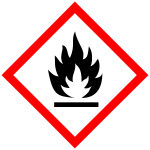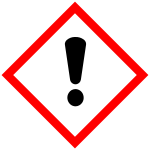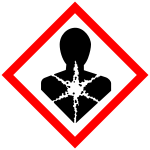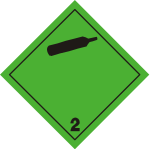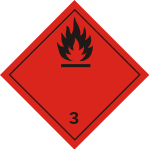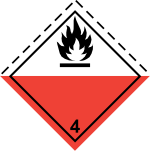| Revision as of 16:26, 22 October 2013 editEboireau (talk | contribs)132 editsm titles harmonization← Previous edit | Revision as of 17:29, 22 October 2013 edit undoEboireau (talk | contribs)132 editsmNo edit summaryNext edit → | ||
| Line 8: | Line 8: | ||
| *the identity of the supplier (who might be a manufacturer or importer) | *the identity of the supplier (who might be a manufacturer or importer) | ||
| The GHS hazard pictograms are intended to replace |
The GHS physical hazard pictograms are intended to provide the basis for or to replace national systems of hazard pictograms, such as the ] ] pictograms or Canada's ] (WHMIS). | ||
| The GHS transport pictograms are the same as those recommended in the ], widely implemented in national regulations such as the U.S. ] (49 U.S.C. 5101–5128) and D.O.T. regulations at 49 C.F.R. 100–185. | |||
| == Physical hazards pictograms == | == Physical hazards pictograms == | ||
Revision as of 17:29, 22 October 2013
Hazard pictograms form part of the Globally Harmonized System of Classification and Labeling of Chemicals (GHS). Two sets of pictograms are included within the GHS: one for the labeling of containers and for workplace hazard warnings, and a second for use during the transport of dangerous goods. Either one or the other is chosen, depending on the target audience, but the two are not used together. The two sets of pictograms use the same symbols for the same hazards, although certain symbols are not required for transport pictograms. Transport pictograms come in wider variety of colors and may contain additional information such as a subcategory number.
Hazard pictograms are one of the key elements for the labelling of containers under the GHS, along with:
- an identification of the product;
- a signal word – either DANGER or WARNING – where necessary
- hazard statements, indicating the nature and degree of the risks posed by the product
- precautionary statements, indicating how the product should be handled to minimize risks to the user (as well as to other people and the general environment)
- the identity of the supplier (who might be a manufacturer or importer)
The GHS physical hazard pictograms are intended to provide the basis for or to replace national systems of hazard pictograms, such as the European Union ] pictograms or Canada's Workplace Hazardous Materials Information System (WHMIS).
The GHS transport pictograms are the same as those recommended in the UN Recommendations on the Transport of Dangerous Goods, widely implemented in national regulations such as the U.S. Federal Hazardous Materials Transportation Law (49 U.S.C. 5101–5128) and D.O.T. regulations at 49 C.F.R. 100–185.
Physical hazards pictograms

|
Usage | |
|---|---|---|
| ||
| Explosive |

|
Usage | |
|---|---|---|
| ||
| Oxidizing |

|
Usage | |
|---|---|---|
| ||
| Compressed Gas |

|
Usage | |
|---|---|---|
| ||
| Corrosive |
| Usage | ||
|---|---|---|
| ||
| no pictogram required |
Health hazards pictograms
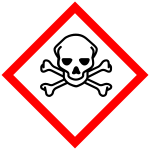
|
Usage | |
|---|---|---|
| ||
| Toxic |

|
Usage | |
|---|---|---|
| ||
| Corrosive |
| Usage | ||
|---|---|---|
| ||
| no pictogram required |
Environmental hazards pictograms
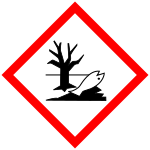
|
Usage | |
|---|---|---|
| ||
| Environmentally Damaging |
| Usage | ||
|---|---|---|
| ||
| no pictogram required |
Transport pictograms
Class 1: Explosives

|
Usage | |
|---|---|---|
Substances and articles which are classified as explosives but which present no significant hazard
The asterisk is replaced by the compatibility code | ||
| Division 1.4 |
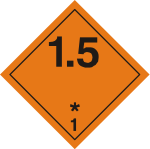
|
Usage | |
|---|---|---|
Very insensitive substances which have a mass explosion hazard
The asterisk is replaced by the compatibility code | ||
| Division 1.5 |

|
Usage | |
|---|---|---|
Extremely insensitive articles which do not have a mass explosion hazard
The asterisk is replaced by the compatibility code | ||
| Division 1.6 |
Class 2: Gases
Classes 3 and 4: Flammable liquids and solids
Other GHS transport classes

|
Usage | |
|---|---|---|
Substances which, while in themselves not necessarily combustible, may, generally by yielding oxygen, cause, or contribute to, the combustion of other material | ||
| Division 5.1 |
| File:GHS Pictogram Skull6.gif | Usage | |
|---|---|---|
Substances with an LD50 value ≤ 300 mg/kg (oral) or ≤ 1000 mg/kg (dermal) or an LC50 value ≤ 4000 ml/m (inhalation of dusts or mists) | ||
| Division 6.1 |
Non-GHS transport pictograms
The following pictograms are included in the UN Model Regulations but have not been incorporated into the GHS because of the nature of the hazards.

|

|

|

|

|

|
| Class 6.2 | Class 7 | Class 9 | |||
|---|---|---|---|---|---|
| Infectious substances | Radioactive material | Miscellaneous dangerous substances and articles | |||
Notes
- Part 1, section 1.4.10.5.1, GHS Rev.2
- Part 1, section 1.4.10.5.2, GHS Rev.2
- Part 1, section 1.4.10.5.3.1, GHS Rev.2
References
- Template:GHS ("GHS Rev.2")
- "Regulation (EC) No 1272/2008 of the European Parliament and of the Council of 16 December 2008 on classification, labelling and packaging of substances and mixtures, amending and repealing Directives 67/548/EEC and 1999/45/EC, and amending Regulation (EC) No 1907/2006", OJCE (L353): 1–1355, 2008-12-31 (the "CLP Regulation")
- UN Recommendations on the Transport of Dangerous Goods. Model Regulations (Fifteenth ed.), New York and Geneva: United Nations, 2007, ISBN 978-92-1-139120-6, ST/SG/AC.10/1/Rev.15 ("UN Model Regulations Rev.15")
- UN Recommendations on the Transport of Dangerous Goods. Manual of Tests and Criteria (Fourth revised ed.), New York and Geneva: United Nations, 2002, ISBN 92-1-139087-7, ST/SG/AC.10/11/Rev.4 ("UN Manual of Tests and Criteria Rev.4")
External links
- GHS pictogram gallery from the United Nations Economic Commission for Europe
